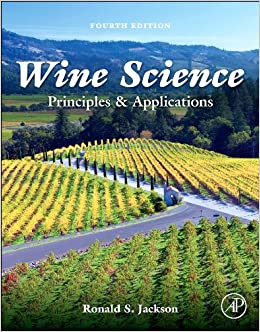
Book Review: Wine Science
If you’re a student of wine–or you just like to know how grapes grow and they make wine–you will definitely appreciate the book Wine Science.
This book, weighing in at almost three pounds, is a requirement of students in the UC Davis Winemaking program.
In my decade of taking an assortment of wine education classes, this is one of the most comprehensive books on the subject of grape growing and winemaking. I have both the physical book, and the Kindle ebook. The reason I have both is that it is much easier to look up certain subjects in the index, when I’m on the go.
**Click Here for Wine Resources**
Wine Science: The Basics of Grape Growing and Wine Making
While Wine Science is best described as a textbook on wine, it is remarkably easy to read.While Wine Science is best described as a textbook on wine, it is remarkably easy to read.
A lot of readers may want to start at the beginning of the book, the section that covers grape growing and vine diseases, and progress linearly towards winemaking.
Other readers may just be interested in delving into subjects on a one by one basis.
For example, imagine that you attend a wine tasting, and everyone around you begins to speak about malolactic fermentation regarding a California Chardonnay.
Once you check the subject in the book, you will find that malolactic fermentation (often called MLF) is a winemaking technique used in white wines, most often Chardonnay, to impart a richer texture and buttery flavor.
The book is written by Ronald S. Jackson, who can break down technical winemaking processes in a way easy for everyone to understand.
**Click Here to Read the Original Review in Forbes.com**
Wine Science Physical Book Vs. eBook
When I first bought Wine Science, my primary concern was whether to invest in the physical book or the eBook.When I first bought Wine Science, my primary concern was whether to invest in the physical book or the eBook.
Both were about $100 dollars.
At first, I thought the physical book would be of better service.At first, I thought the physical book would be of better service.
I thought I would keep it on my desk, and refer to it several times a day (and I did!) when I needed a quick answer to one of the winemaking questions I was studying on my exam.
But after a year of lugging this giant book from my office to a dedicated reading room on another floor, I decided that an ebook would be more convenient.
The Wine Science Ebook
Within 20 seconds of purchasing the ebook from Amazon, it was right that in my Kindle application.
From that very first moment, I absolutely loved how all the knowledge of Wine Science was literally at my fingertips.
This meant that I could brush up on pruning techniques (yes, my exam covered that topic) when I was riding a subway from Point A to Point B in New York. Or that unlike the book, I could quickly use the “search” function in the eBook to find my query in seconds.
Is Wine Science Right for Everyone?
Even though author Ronald S. Jackson writes in an easy-to-understand tone and includes a lot of illustrations in both the physical book and eBook, it is not a book for everyone.
First, not everyone needs this deep level of knowledge. And the price tag renders it un-affordable for most normal wine lovers who do not need this deeply rooted knowledge to pass a University level wine exam.
That said, it is by far the most complete book on the market today that covers everything form rootstocks to clones to the details of how to make wine in one complete package.
Alternatives to Wine Science
If after reading this review you feel that Wine Science is too much for you, here are some great alternatives.
One fantastic book is Grapes & Wine, by Oz Clark. It is easy to read and entertaining. This book is organized by grape, so in each “chapter” you will learn about international grape varieties in terms of the countries where they grow, what the wine smells and tastes like, and also common winemaking techniques.
The other book is Wine Folly, by Madeline Puckette. The first paperback edition is very easy to read, light weight, and portable. Now you can also find it in eBook form. The idea is to look up a grape that interests you. When you turn to that page, you will find a colorful infographic that tells you as specifically as possible the aromas and flavors in that wine. This was a great resource when I was attaining my many degrees as a sommelier and winemaker.
That said, I still think Wine Science is an influential book for the serious student of wine.
Like this article? Check out these excellent wine book reviews here.
Please SHARE this article, visit the social media links and subscribe to my newsletter here
If you like this article you will like:
— Dominus Estate
— Chappellet Family Winery
— Hess Collection
— Frog’s Leap
Curious to Learn More About Wine? Start Here
Want to Grab Quick Wine Resources
About Author Marisa D’Vari
D’Vari contributes to Forbes.com, Financial Times, World of Fine Wine, Quarterly Review of Wine, Decanter Robb Report, San Francisco Chronicle, South China Morning Post, and more.
She holds the (WSET) diploma, Certified Sommelier through the Court of Master Sommeliers, a Certified Wine Educator through the Society of Wine Educators … to see it all, please click on bio
Curious to Learn More About Wine? Start Here